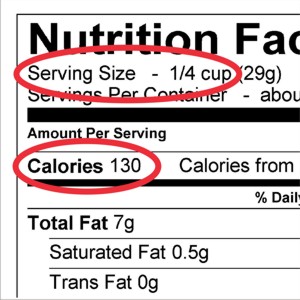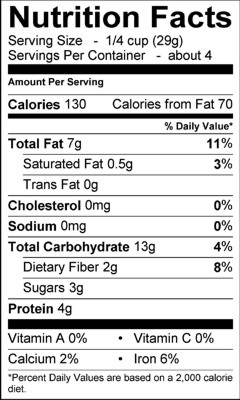We’ve recently offered a number of posts, here in the FFB, which mention nutrition profiles and labeling regulations. The profiles make good reading, but they can be deceptive. How? You have to check the serving size quoted on the label and calculate equivalent numbers accordingly.
So… Say you’re comparing one jar of jam with another and they both contain the same ingredients, you look at the nutrition profile on the back to see how they stack up for sugar, salt, fat, and so on. One appears to have significantly more sugar than the other.
____________________________________
This nutrition profile, for a more or less
standard granola, bases its numbers on a
1/4 cup serving! The average person will eat
a full cup. That translates to 520 calories
per real serving – a quarter of your daily
allotment – and almost half your daily
allotment of fat!
____________________________________
But then… You look closer and see that the ‘healthier’ option is basing its nutrition figures on a serving size of one tablespoon, while the other product is basing its numbers on a serving size of two tablespoons. Divide the figures stated for the second option in half and it could turn out to be ‘healthier’, tablespoon for tablespoon, than the first!
And be realistic about the portion sizes you actually consume. Nobody puts just two tablespoons of jam on their toast. More like four. And most folks eat two pieces of toast at breakfast!
Breakfast cereal is another processed food category where manufacturers like to minimize stated portion sizes in their nutrition profiles and ‘suggested serving’ sizes. The average person pours a cup and a half or two cups of cereal into their morning bowl. But the ‘serving’ sizes printed on most cereal packages fall within the range of one-half to three quarters of a cup.
A biscuit package may display a pile of six cookies, but you might just find that the serving size used to calculate the nutrition facts numbers on the back of the box is based on a three-cookie serving!
There’s no lie, technically. But, like a magician, the food manufacturers misdirect your attention by minimizing the serving size on which their nutrition numbers are based, to create the illusion that their products are ‘healthier’ than they really are.
Cave consumer! And make sure to run the numbers before you buy!
~ Maggie J.


